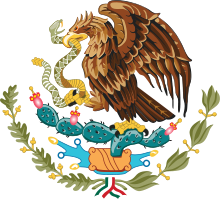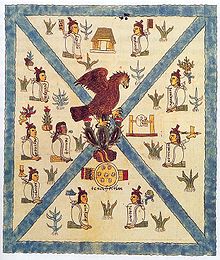- National symbols of Mexico
-
The national symbols of Mexico are the flag,the coat of arms and the national anthem .The flag is a vertical tricolor of green , white , and red. The coat of arms features a golden eagle eating a snake on top of a cactus.
Contents
National flag
Main article: Flag of MexicoThe current national flag was adopted on September 16, 1968, and was confirmed by law on February 24, 1984. The current version is an adaptation of the design approved by presidential decree in 1916 by Venustiano Carranza, where the eagle was changed from a front-facing to a side-facing position.[1] The current flag is a vertical tricolor of green, white, and red with the national coat of arms charged in the center of the white stripe. While the meaning of the colors has changed over time, these three colors were adopted by Mexico following independence from Spain during the country's War of Independence.
 Flag of the Three Guarantees.[2]
Flag of the Three Guarantees.[2]
The colors of the flag originated from the banner of the Army of the Three Guarantees, which lasted from 1821 until 1823. Originally, the colors had the following meanings:[3]
- Green: Independencia (independence from Spain)
- White: Religión (religion, the Roman Catholic faith)
- Red: Unión (union between the Europeans and Americans)
However, the meaning of the colors changed because of the secularization of the country, which was spearheaded by President Benito Juárez.[4] The new color meanings are as follows:
- Green: Hope
- White: Unity
- Red: Blood of the national heroes
The World Encyclopedia of Flags, a book written by Alfred Znamierowski, also gives the following meaning to the colors of the flag:[3]
- Green: Hope
- White: Purity
- Red: Religion
Since Article 3 of the Flag Law does not give an official symbolism to the colors, other meanings may be given to them. Other groups have used the national colors as part of their own logos or symbols. For example, the Institutional Revolutionary Party (PRI) political party has adopted the national colors as part of their logo. Another political party, the Party of the Democratic Revolution (PRD), also had the national colors as part of their logo, but changed them in the 1990s after a controversy surrounding impartiality issues, while the PRI did not.[5] Several states, such as Querétaro and Hidalgo have incorporated either elements of the national flag, or even the entire flag, into their coat of arms.
Coat of arms
Main article: Coat of arms of MexicoAccording to the official story of Mexico, the coat of arms of Mexico was inspired by an Aztec legend regarding the founding of Tenochtitlan. The Aztecs, then a nomadic tribe, were wandering throughout Mexico in search of a divine sign that would indicate the precise spot upon which they were to build their capital.
A closer look at the original Aztec codices, paintings, and the post-Cortesian codices shows that there was no snake in the original legends. While the Codex Fejérváry-Mayer depicts an eagle attacking a snake, other Aztec illustrations, like the Codex Mendoza, show only an eagle, while in the text of the Ramírez Codex, Huitzilopochtli asked the Aztecs to look for an eagle devouring a snake perched on a prickly pear cactus. In the text by Chimalpahin Cuauhtlehuanitzin, the eagle is devouring something, but it is not mentioned what it is. Still other versions show the eagle clutching the Aztec symbol of war, the Atl-Tlachinolli glyph, or "burning water".
The bird featured on the Mexican coat of arms is the Golden Eagle. This bird is known in Spanish as águila real (literally, "royal eagle"). In 1960, the Mexican ornithologist Martín del Campo identified the eagle in the pre-Hispanic codex as a Northern Caracara or "quebrantahuesos", a species common in Mexico (although the name "eagle" is taxonomically incorrect, as the caracara is a type of falcon). Even so, the Golden Eagle is considered the Mexican eagle for official purposes, and for the same reason is considered the official bird of Mexico.
National anthem
Main article: Himno Nacional MexicanoThe National Anthem of Mexico (Spanish: Himno Nacional Mexicano) was officially adopted in 1943. The lyrics of the national anthem, which allude to Mexican victories in the heat of battle and cries of defending the homeland, were composed by poet Francisco González Bocanegra in 1853, after his fiancée locked him in a room. In 1854, Jaime Nunó arranged the music which now accompanies González's poem. The anthem, consisting of ten stanzas and a chorus, entered into use on September 16, 1854. From 1854 until its official adoption, the lyrics underwent several modifications due to political changes in the country.
At the same time the lyrics were chosen, a set of music was chosen. The winner was Juan Bottesini, but his entry was disliked due to aesthetics. This rejection caused a second national contest to find music for the lyrics.[6] At the end of the second contest, the music that was chosen for González's lyrics was composed by Jaime Nunó, a Spanish-born band leader. At the time of the second anthem competition, Nunó was the leader of several Mexican military bands. He had been invited to direct these bands by President Santa Anna, whom he had met in Cuba. Officially since 1943, the full national anthem consists of the chorus, 1st stanza, 5th stanza, 6th stanza and 10th stanza.
The modification of the lyrics was ordered by President Manuel Ávila Camacho in a decree printed in the Diario Oficial de la Federación.[7] The de jure or official language of Mexico is Spanish. Nevertheless there are still people who only speak indigenous languages. On December 8, 2005, Article 39 of the national symbols law was adopted to allow for the translation of the lyrics into the native languages. The official translation is performed by the National Institute of Indigenous Languages (Instituto Nacional de Lenguas Indígenas).[8]
References
- ^ Juán López de Escalera Diccionario Biográfico y de Historia de México, Editorial del Magisterio, México, 1964.
- ^ Universidad de Guadalajara "History of the Mexican Flag" [1]. (es)
- ^ a b Znamierowski, Alfred. The World Book of Flags 2002, Hermes House; London; page 200
- ^ Benito Juárez's biography on the website of former President Ernesto Zedilo
- ^ Christian Science Monitor article on the PRI logo controversy
- ^ Embassy of Mexico in Serbia and Montenegro Mexican Symbols—Himo. Retrieved Mar. 19, 2006.
- ^ Administration of Ernesto Zedillo National Symbols of Mexico. Retrieved Mar. 15, 2006.
- ^ Diario Oficial de la Federación—Decree allowing for translation of the anthem into native languages. Dec. 7, 2005. Retrieved Jan. 11, 2006
External links
National symbols of North America Sovereign states Antigua and Barbuda · Bahamas · Barbados · Belize · Canada · Costa Rica · Cuba · Dominica · Dominican Republic · El Salvador · Grenada · Guatemala · Haiti · Honduras · Jamaica · Mexico · Nicaragua · Panama · Saint Kitts and Nevis · Saint Lucia · Saint Vincent and the Grenadines · Trinidad and Tobago · United States
Categories:
Wikimedia Foundation. 2010.



